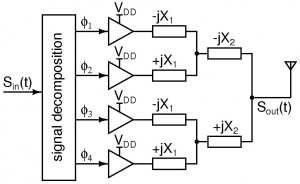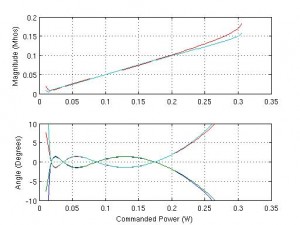A New Outphasing Power Combiner for Efficient RF Power Amplification
- Category: Circuits & Systems
- Tags: David Perreault, Joel Dawson, Taylor Barton
With modern digital communications applications moving towards increasingly high data rates, efficient spectral use requires modulation with dense constellations. The denser the constellation, the more important the average efficiency of the power amplifier becomes. Conventional power amplifier (PA) options such as Class A or B amplifiers have the necessary linearity for dense constellations but have poor efficiency at low output powers. Outphasing solutions, which use efficient switching PAs and power combining, seek to break the efficiency/linearity tradeoff in PA design. This work focuses on a lossless multi-way power combining and outphasing system originally presented in [1] that provides both high efficiency and linear output control.
Outphasing was proposed by Chireix for radio frequency (RF) transmitters using a lossless combiner and two PAs [2] . The effective load impedance seen by each PA during operation depends on the commanded total output power. The efficiency of each PA itself depends on the load. This effect can be described using the power factor of the load, with power factor defined as the ratio of the real part of the load impedance to the magnitude of the impedance. The PA efficiency for a typical PA design is proportional to power factor, so that the PA load reactance is a key design criterion for a combiner. A related approach to Chireix outphasing, linear amplification with nonlinear components (LINC), enforces a unity power factor for the PAs by using an isolating combiner [3] . The combiner input port impedance is always 50 ohms, independent of the total output power. Since the constant load means that the switching PAs are operating at constant output power, power not delivered to the load must be dissipated in an isolation resistor. As a result the system efficiency is degraded for low output power levels.
The goal of this work is to develop a new lossless multi-way outphasing system that overcomes the limitations of previous outphasing systems. Based on the system proposed in [1] , the outphasing system shown in Figure 1 uses four switching PAs and an outphasing control strategy that provides linear control over a wide dynamic range while limiting the reactance of the loads seen by each PA. By providing ideally lossless combining and nearly resistive loading, this system is expected to allow high average efficiency for amplification of signals even with large peak-to-average power ratios. A combiner design parameter determines the relationship between branch reactances and determines the tradeoff between dynamic range and maximum load reactance. Figure 2 shows the magnitude and phase of the load impedances of the new power combiner and outphasing system for one choice of design parameters. The figure shows that the new system has small a reactive load component over a wide power range.
- Figure 1: The new power combining and outphasing system.
- Figure 2: Magnitude and phase of the four PA load impedances.
- D. J. Perreault, “A new power combining and outphasing modulation system for high-efficiency power amplification,” IEEE Transactions on Circuits and Systems I: Regular Papers, Oct. 2011. [↩] [↩]
- H. Chireix, “High power outphasing modulation,” Proc. IRE, Nov. 1935, vol. 23, no. 11, pp. 1370-1392. [↩]
- D. Cox, “Linear amplification with nonlinear components,” IEEE Transactions on Communications, vol. 12, pp. 1942-1945, Dec. 1974. [↩]

